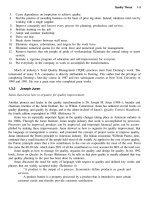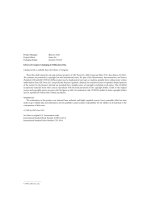Dimensioning and Tolerancing Handbook P1
Bạn đang xem bản rút gọn của tài liệu. Xem và tải ngay bản đầy đủ của tài liệu tại đây (877.93 KB, 30 trang )
Dimensioning and Tolerancing
Handbook
Paul J. Drake, Jr.
McGraw-Hill
New York San Francisco Washington , D.C. Auckland Bogata
Caracas Lisbon London Madrid Mexico City Milan
Montreal New Delhi San Juan Singapore
Sydney Tokyo Toronto
McGraw-Hill
A Division of The McGraw-Hill Companies
Copyright 1999 by Paul J. Drake, Jr. All rights reserved. Printed in the United States
of America. Except as permitted under the United States Copyright Act of 1976, no part
of this publication may be reproduced or distributed in any form or by any means, or
stored in a data base or retrieval system, without the prior written permission of the
publisher.
1 2 3 4 5 6 7 8 9 0 QM/QM 9098765432109
ISBN 0-07-018131-4
The sponsoring editor of this book was Linda Ludewig, and the production supervisor
was Pamela Pelton.
Printed and bound by Quebecor/Martinsburg.
Information contained in this work has been obtained by The McGraw-Hill Companies,
Inc. (“McGraw-Hill”) from sources believed to be reliable. However, neither McGraw-
Hill nor its authors guarantees the accuracy or completeness of any information pub-
lished herein and neither McGraw-Hill nor its authors shall be responsible for any errors,
omissions, or damages arising out of use of this information. This work is published with
the understanding that McGraw-Hill and its authors are supplying information but are
not attempting to render engineering or other professional services. If such services are
required, the assistance of an appropriate professional should be sought.
This book is printed on recycled, acid-free paper containing a minimum of
50% recycled, de-inked fiber.
McGraw-Hill books are available at special quantity discounts to use as premiums and
sales promotions, or for use in corporate training programs. For more information,
please write to the Director of Special Sales, McGraw-Hill, 11 West 19th Street, New
York, NY 100011. Or contact your local bookstore.
xxii
About the Editor
Paul Drake is a Principal Engineer with Honors at the Raytheon Systems Company where he trains and
consults in variation management, GD&T and Six Sigma mechanical tolerancing. He began the Mechani-
cal Tolerancing and Performance Sigma Center for Excellence at Raytheon (formerly Texas Instruments,
Inc.) in 1995. This center develops and deploys dimensioning and tolerancing best practices within
Raytheon. As a member of the Raytheon Learning Institute, Paul has trained more than 3,500 people in
GD&T and mechanical tolerancing in the past 12 years. He has also written numerous articles and
design guides on optical and mechanical tolerancing.
Paul has ASME certification as a Senior Level GD&T Professional. He is a Subject Matter Expert
(SME3) to ASME’s Statistical Tolerancing Technical Subcommittee, a member of ASME’s Geometric
Dimensioning and Tolerancing Committee, a Six Sigma Blackbelt, and a licensed professional engineer in
Texas. He holds two patents related to mechanical tolerancing.
Paul resides in Richardson, Texas, with his wife Jane and their three children.
xxiii
Contributors
Timothy V. Bogard
Sigmetrix
Dallas, Texas
Chapter 26
Kenneth W. Chase, Ph.D.
Brigham Young University
Provo, Utah
Chapters 13, 14, and 26
Tom S. Cheek, Jr., Ph.D
Six Sigma Design Institute
Dallas, Texas
Reviewer
Chris Cuba
Raytheon Systems Company
McKinney, Texas
Chapter 23
Gordon Cumming
Raytheon Systems Company
McKinney, Texas
Reviewer
Don Day
Monroe Community College
Rochester, NY
Chapter 26
Scott DeRaad
General Motors Corporation
Ann Arbor, Michigan
Chapter 6
Paul Drake
Raytheon Systems Company
Plano, Texas
Chapters 5, 9, and 26
Charles Glancy
Raytheon Systems Company
Dallas, Texas
Chapter 15
Gregory A. Hetland, Ph.D.
Hutchinson Technology Inc.
Hutchinson, Minnesota
Chapters 3, 20, 25, and 26
Michael D. King
Raytheon Systems Company
Plano, Texas
Chapter 17
Alex Krulikowski
General Motors Corporation
Westland, Michigan
Chapter 6
Marvin Law
Raytheon Systems Company
Dallas, Texas
Chapter 15
Percy Mares
Boeing
Huntington Beach, California
Reviewer
Paul Matthews
Ultrak
Lewisville, TX
Chapter 16
Patrick J. McCuistion, Ph.D
Ohio University
Athens, Ohio
Chapter 4
James D. Meadows
Institute for Engineering & Design, Inc.
Hendersonville, Tennessee
Chapter 19
Jack Murphy
Raytheon Systems Company
Dallas, Texas
Reviewer
xxiv Contributors
Mark A. Nasson
Draper Laboratory
Cambridge, Massachusetts
Chapter 7
Al Neumann
Technical Consultants, Inc.
Longboat Key, Florida
Chapter 26
Robert H. Nickolaisen, P.E.
Dimensional Engineering Services
Joplin, Missouri
Chapter 2
Ron Randall
Ron Randall & Associates, Inc.
Dallas, Texas
Chapters 1 and 10
Vijay Srinivasan, Ph.D
IBM Research and Columbia University
New York
Chapter 8
Walter M. Stites
AccraTronics Seals Corp.
Burbank, California
Chapter 5
James Stoddard
Raytheon Systems Company
Dallas, Texas
Chapter 15
Dale Van Wyk
Raytheon Systems Company
McKinney, Texas
Chapters 11 and 12
Stephen Harry Werst
Raytheon Systems Company
Dallas, Texas
Chapter 24
Robert Wiles
Datum Inspection Services
Phoenix, Arizona
Reviewer
Bruce A. Wilson
Aerospace Industry
St. Louis, Missouri
Chapter 26
Martin P. Wright
Behr Climate Systems, Inc.
Fort Worth, Texas
Chapter 18
Paul Zimmermann
Raytheon Systems Company
McKinney, Texas
Chapter 22
Dan A. Watson, Ph.D.
Texas Instruments Incorporated
Dallas, Texas
Chapter 21
xxix
Acknowledgments
I am grateful to the authors for their personal sacrifices and time they dedicated to this project. I am
especially grateful to four people who have influenced my personal life, my career, and the writing of this
book.
· Jane Drake, my wife, for her tireless editing and unwavering support
· Dr. Greg Hetland for his vision of the big picture
· Walt Stites for his meticulous detail and understanding of Geometric Dimensioning
and Tolerancing
· Dale Van Wyk for helping me understand statistical tolerancing
I am also grateful to the following people for their support and help in this effort.
· Bob Esposito and Linda Ludewig from McGraw-Hill for their faith in this work
· Sally Glover from McGraw-Hill for proofing the work
· Mike Tinker, Ted Moody, and Rita Casavantes for their management support
· Todd Flippin for his late-night help keeping the computers running
· Gene Mancias for the wealth of graphic support
· Kelli and Joe Mancuso (The Training Edge) for help with the layout and design
· Scott Peters for his help with the index and printing
· Douglas Winters III for his artistic talents, graphics, and cover design
I wish to thank the reviewers Tom Cheek, Gordon Cumming, Percy Mares, Jack Murphy, and Bob
Wiles for their careful and thorough review of this material.
I am deeply indebted to Lowell Foster, for his review and endorsement of this work.
I especially want to thank my wife, Jane, for her patience, endless hours of editing, and perseverance.
I could not have done this without her.
I wish to dedicate this book to God; my parents, Anne and Paul Drake; and my wife Jane and children
Taylor, Ellen, and Madeline.
xxi
Foreword
Between the covers of this remarkable text one can experience, at near warp speed, a journey through the
cosmos of subject matter dealing with dimensioning and tolerancing of mechanical products. The
editor, as one of the contributing authors, has aptly summarized the content broadly as “about product
variation.” The contained chapters proceed then to wend their way through the various subjects to
achieve that end. Under the individual pens of the authors, the wisdom, experience, writing style, and
extensive research on each of the concerned topics presents the subject details with a unique richness.
The authors, being widely renowned and respected in their fields of endeavor, combine to present a
priceless body of knowledge available at the fingertips of the reader.
If not a first, this text surely is one of the best ever compiled as a consolidation of the contained
related subjects. While possibly appearing a little overwhelming in its volume, the book succeeds in
putting the reader at ease through the excellent subject matter arrangement, sequential flowing of chap-
ters, listing of contents, and a complete index. The details of each chapter are self-explanatory and
present “their story” in an enlightening, albeit challenging sometimes, individual style. Collectively, the
authors and their respective chapters seem to reflect considerations and lessons learned from the past,
inspiration and creativity for the state-of-the-art of the present, and insightful visions for the future. This
text then equally represents a kind of status report of the various involved technologies, guidance and
instruction for absorbing and implementing technical content, and some direction to the future path of
progress.
Reflecting upon the significant contribution this text adds to the current state of progress on the
contained subjects, a feeling of confidence prevails that there is no fear for the future— to the contrary,
only a relish for the enlarging opportunities time will provide. Congratulations to the editor, Paul Drake,
for his insight in conceiving this text and to all the authors and contributors. Your product represents a
major achievement in its addition to the annals of product engineering literature. It is also a record of our
times and a glimpse of the future. It is a distinct pleasure to endorse this text with added thanks for all the
dedicated energy expended in behalf of this project and the professions involved. Your work will bring
immediate returns and will also instill a pride of accomplishment on behalf of yourselves, our country, and
the global community of industrial technology.
Lowell W. Foster
Lowell W. Foster Associates, Inc.
Minneapolis, Minnesota
xxv
Preface
This book is about transitioning from mechanical product design to manufacturing. The cover graphic
illustrates two distinct phases of product development. The gear drawing (computer model) represents
a concept that is perfect. The manufactured gear is imperfect. A major barrier in the journey from
conceptual ideas to tangible products is variation. Variation can occur in the manufacturing of products,
as well as in the processes that are used to develop the products.
This book is about mechanical product variation: how we understand it, how we deal with it, and how
we control it. As the title suggests, this book focuses on documenting mechanical designs (dimension-
ing) and understanding the variation (tolerancing) within the product development process. If we ac-
cept all product variation into our design, our products may not function as intended. If we throw away
parts with too much variation, our product costs will increase.
This book is about how we balance product variation with customer requirements. We generally deal
with product variation in three ways.
• We accept product variation in our designs;
• We control product variation in our processes; or
• We screen out manufactured parts that have more variation than the design will allow.
Many experts refer to this balance between design requirements and manufacturing variation as
dimensional management. I prefer to call it variation management. After all, variation is usually the
primary contributor to product cost.
In order to manage variation we must understand how variation impacts the mechanical product
development process.
This book is process driven. This book is not just a collection of related topics. At the heart of this book
is the variation management process. Fig. P-1 shows a generic product development process, and
captures the key activities we put in place to manage product variation. Your product development
process may be similar in some areas and different in others, but I believe Fig. P-1 captures the essence of
the design process.
Fig. P-1 does not try to document everything in the variation management process. This information
is contained within the chapters. The purpose of Fig. P-1 is twofold; first, it gives a birds-eye view of the
process to help the reader understand the “big-picture,” and second, it is a starting point to show the
reader where each chapter in the book fits into this process.
xxvi Preface
Figure P-1 Product development process
Verification/Test
- Piecepart
- Subassembly
- Full assembly
Analysis tools
- Attribute (Functional / paper gaging)
- Variable
Measurement
Document capabilities
- Machine tolerances /
specifications
- Process capabilities
Product Design Cycle
Design Manufacturing
Verification/Test
External Influences
- Customer defined
performance /
functional requirements
- National, international,
and industry standards
Internal
Influences
- Internal
constraints
- Internal
standards
- Best practices
- Training
Supplier
Influences
- Supplier
constraints
- Tooling
Tolerancing Methodology
- Worst case
- Root sum squared
- Six Sigma optimization
- Cost / yield optimization
System Design
Establish dimensioning and
tolerancing approach to
support functional needs
Understand functional
design requirements
Detailed Design
Manual drawing layout (2-D)
or
Computer Aided Design (3-D)
Mechanical Design (Product, Equipment, and Tooling)
Design documentation
Tolerance re-allocation
Tolerance analysis tools
Assembly
Subassembly
Full assembly
Feature based /
task specific
Assess measurement error
Components
Machining
Statistical
Process
Control
Verification/Test
- Piecepart
- Subassembly
- Full assembly
Analysis tools
- Attribute (Functional / paper gaging)
- Variable
Measurement
Document capabilities
- Machine tolerances /
specifications
- Process capabilities
Product Design Cycle
Design Manufacturing
Verification/Test
External Influences
- Customer defined
performance /
functional requirements
- National, international,
and industry standards
Internal
Influences
- Internal
constraints
- Internal
standards
- Best practices
- Training
Supplier
Influences
- Supplier
constraints
- Tooling
Tolerancing Methodology
- Worst case
- Root sum squared
- Six Sigma optimization
- Cost / yield optimization
System Design
Establish dimensioning and
tolerancing approach to
support functional needs
Understand functional
design requirements
Detailed Design
Manual drawing layout (2-D)
or
Computer Aided Design (3-D)
Mechanical Design (Product, Equipment, and Tooling)
Design documentation
Tolerance re-allocation
Tolerance analysis tools
Assembly
Subassembly
Full assembly
Feature based /
task specific
Assess measurement error
Feature based /
task specific
Assess measurement error
Components
Machining
Statistical
Process
Control
Preface xxvii
Each chapter of this book is linked to the product development process. The book is divided into seven
parts that map to the process. Each chapter details the activities associated with the variation manage-
ment process. By no means does this book capture everything. Although there is a wealth of information
here, there is an endless amount of information that we could add. Likewise, new techniques, processes,
and technologies will continue to evolve.
Although each chapter is a piece of the variation management puzzle, each chapter can stand alone.
In practice, however, it is important to understand how each piece of the puzzle relates to others.
This book is about assessing design risk. If we understand the sources of product variation, and we
understand the process(es) to manage them, we are well on our way to designing competitive products
that meet customer requirements. If we capture the sources of variation and input these into the design
process, we can assess the risk of meeting the manufacturing requirements as well as the performance of
our designs.
Several experts contributed to this book. Each chapter reflects a wealth of experience from its author(s),
many of whom are nationally and internationally recognized experts in their fields. This book could not
contain the depth of information that it contains, without so many qualified contributors.
The audience for this book is very broad. Because it looks at the entire process of managing product
variation, the audience for this book is large and very diverse. As a minimum, however, I suggest that
everyone read the first chapter and the last chapter. Chapter 1 is a high-level historical perspective of
where product quality has focused in the past. Chapter 26 is a compilation of where we think we will be in
the future. Chapters 2 through 25 tell us how we are getting there today.
I appreciate any comments you have. Please send them to me at
Paul Drake
v
Foreword .................................................................................................................xxi
About the Editor.........................................................................................................xxii
Contributors..............................................................................................................xxiii
Preface ................................................................................................................ xxv
Acknowledgments ....................................................................................................xxix
Part 1 History/Lessons Learned
Chapter 1: Quality Thrust ............................................................................. Ron Randall
1.1 Meaning of Quality ...................................................................................................................... 1-1
1.2 The Evolution of Quality ............................................................................................................. 1-2
1.3 Some Quality Gurus and their Contributions ........................................................................ 1-2
1.3.1 W. Edwards Deming .................................................................................................................... 1-2
1.3.2 Joseph Juran ............................................................................................................................... 1-3
1.3.3 Philip B. Crosby ........................................................................................................................... 1-4
1.3.4 Genichi Taguchi ........................................................................................................................... 1-5
1.4 The Six Sigma Approach to Quality.......................................................................................... 1-6
1.4.1 The History of Six Sigma............................................................................................................ 1-6
1.4.2 Six Sigma Success Stories ....................................................................................................... 1-7
1.4.3 Six Sigma Basics ......................................................................................................................... 1-7
1.5 The Malcolm Baldrige National Quality Award (MBNQA) ...................................................... 1-9
1.6 References................................................................................................................................. 1-10
Chapter 2: Dimensional Management .................................. Robert H. Nickolaisen, P.E.
2.1 Traditional Approaches to Dimensioning and Tolerancing................................................. 2-1
2.1.1 Engineering Driven Design........................................................................................................ 2-2
2.1.2 Process Driven Design .............................................................................................................. 2-2
2.1.3 Inspection Driven Design .......................................................................................................... 2-2
2.2 A Need for Change ...................................................................................................................... 2-3
2.2.1 Dimensional Management ........................................................................................................ 2-3
2.2.2 Dimensional Management Systems ....................................................................................... 2-3
2.2.2.1 Simultaneous Engineering Teams .......................................................................................... 2-4
2.2.2.2 Written Goals and Objectives ................................................................................................... 2-4
2.2.2.3 Design for Manufacturability (DFM) and Design for Assembly (DFA)................................ 2-5
2.2.2.4 Geometric Dimensioning and Tolerancing (GD&T)............................................................... 2-6
2.2.2.5 Key Characteristics .................................................................................................................... 2-6
2.2.2.6 Statistical Process Control (SPC) ............................................................................................ 2-6
2.2.2.7 Variation Measurement and Reduction .................................................................................. 2-7
2.2.2.8 Variation Simulation Tolerance Analysis ................................................................................ 2-7
2.3 The Dimensional Management Process ................................................................................ 2-8
2.4 References................................................................................................................................. 2-10
2.5 Glossary...................................................................................................................................... 2-10
Contents









